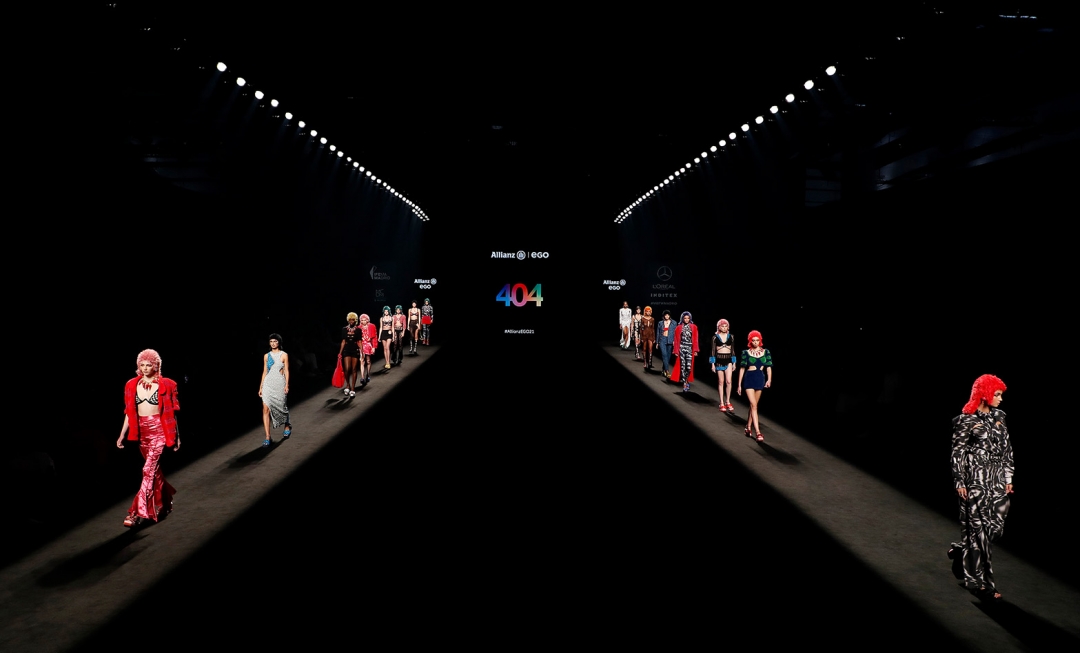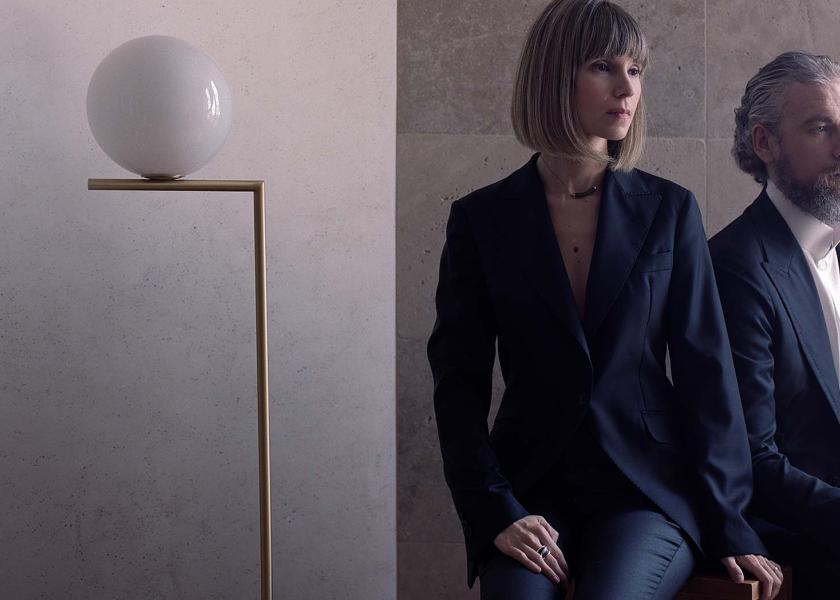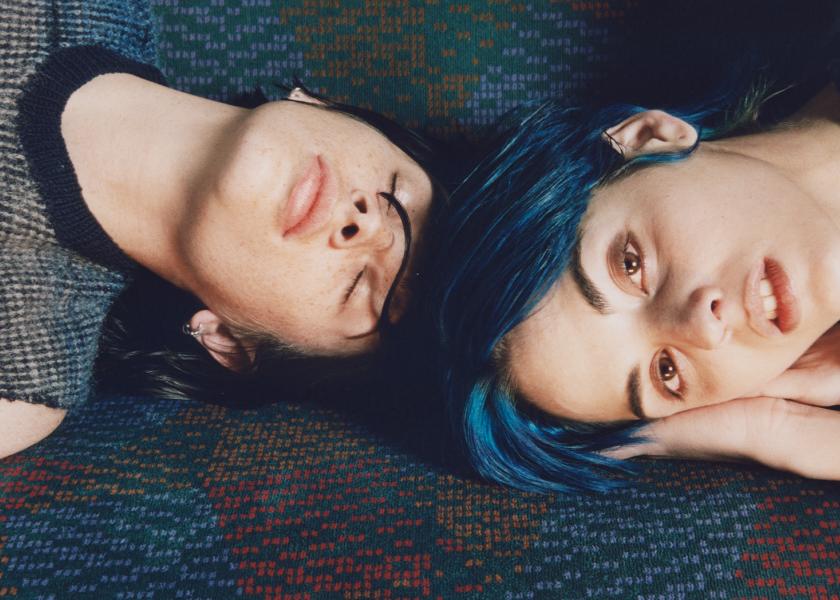404 Studio
Cult of Crochet

Anaïs Vauxcelles is the talent behind 404 Studio; the brand that has made celebrities fall in love with crochet. Her contemporary and sustainable vision of fashion landed her the best emerging collection of the year in the latest edition of the Mercedes-Benz Fashion Week Madrid (MBFWM). Having arrived from Los Angeles, where she had just presented her work, she reveals to us the secrets that comprise new, high-flying fashion craftsmanship.
Under the nomenclature of the best-known error on the Internet, Anaïs Vauxcelles (Valencia, 1991) presents her creative workshop: 404 Studio. But this fashion house has little to do with the errors. The brand, which amalgamates crochet, cult cinema and a leisurely cadence with a contemporary cut, won the Mercedes-Benz Fashion Talent award last September at the 74th MBFWM. An award that comes after four years of travel, which have been enough for Vauxcelles to present a collection at David Lynch's Parisian club, or feature in the looks of celebrities such as Dua Lipa, Kylie Minogue and Griff. In addition to this impressive artistic profile, 404 Studio boasts a sustainability manifesto with a philosophy that translates into the slow production of handcrafted pieces and annual collections in which the concept always prevails.
Fashion is a very challenging industry, what are the keys to 404 Studio's success?
When I started working at 404 Studio my only mission (or vision) was to launch a brand that was different. Very unique, both visually and narratively. I not only wanted to talk about sustainability, but also about tradition, to give a twist to the narrative and link it with cult cinema. I imagine it has something to do with the fact that I never studied fashion, but rather fine arts.
Crochet is part of 404 Studio's DNA, why so?
It was simply something that I came across along the way. It happened when the brand was gestating four years ago and my mother started knitting. She knew that I really liked design, she taught me the technique and we started making tops together that we sold to friends and acquaintances. At that time, almost no one made crochet fashion, it was something very different. I was on the look out for a resource that would attract attention, so I started working with it. I set a three-year window to see if it could become a success, and if it got nowhere, I intended to quit. But now I can't.
“I not only wanted to talk about sustainability, but also about tradition, to give a twist to the narrative and link it with cult cinema”
Where does your passion for fashion come from?
My grandmother sewed a lot and taught me the technique when I was very young. Then I started designing outfits for my dolls. I am an only child and I spent hours with her making crafts. At that time, I was just 8 or 9 years old and still did not know how to make patterns.
However, you did not continue studying Fashion, why?
At first, I wanted to study fashion. I started a semester, but it wasn't for me. I didn’t like the subjects, I felt they restricted me a lot. It was my mother who eventually encouraged me to study fine art to acquire a more global vision of what art is in general. Because, for me, fashion is not just clothing, but a way of telling a story, almost like a canvas.

The brand was proclaimed the winner of the 18th edition of Mercedes-Benz Fashion Talent. © Image courtesy of 404 Studio
What is the creative process that you follow in your collections?
What inspires me the most is the art direction; that’s what the master's degree I did at the end of my studies was all about. For me, it is essential. I always refer to the fact that in Almodóvar's films the one forgotten is Antxon Gómez, who is the art director and the person in charge of the ‘Almodóvar aesthetic’. I am interested in this form of storytelling; I do not focus on what the characters are wearing, but with the meaning behind it. From there, I do an analysis of the form and think about the materials that I would like to use. In the end it is a process of doing and undoing, because the end point is reworked like that, until it is finally as you want it.
Is this why storytelling is so important at 404 Studio?
Yes, it is the reason why I normally use the films. The titles I choose have a very strong art direction. They are usually related to science fiction as I really like that genre and I am very retro-futuristic. I am guided by stories that usually have a hidden moral or plot. La Planète Sauvage, the film that inspired my latest collection, deals with beings that live on another planet and the invaders are humans. In the end, what counts is that there are no species superior to others, that the most important thing is education and that knowledge is power. That is what we try to tell through this collection.
"For me, fashion is not just clothing, but a way of telling a story, almost like a canvas"
So, do you think that fashion can stir consciences?
Many people believe that fashion is banal, but for me it’s the opposite. When thinking of a historical period, the first thing that comes to mind is clothing. It is closely linked to architecture in that sense. Fashion speaks of our collective currents and it’s a reflection of society. For example, the fact that we have re-embraced the crochet tradition is not accidental. We are a society that lives so fast that the return to slow is inevitable. It is the reason why I design slow fashion; it is a vindication. We have to stop, think things through and then continue on. In this way, crochet is created. It cannot be imitated by machine, it can only be knitted by hand. Everything I create is touched by human hands and that has true value.
The catwalk is characterized by temporality, how do you adapt this slow philosophy to the shows?
For me, the catwalk is important because of the experience it offers and the way it allows you to reach the consumer. There is a lot of talk about experiential marketing and I am a great advocate for it. It is just not the same if they show you a photo of a dress compared to one that you see in live motion, with a wig that transports you to a totally alien universe, while listening to music that tells a story. All this immerses you in the designer's narrative and thus connects to the public.
In addition to using recycled fabrics and producing locally, what is your approach to sustainability?
During the pandemic I wrote a brand manifesto. I think that one way to fight overproduction is to design a single collection per year, encompassing spring, summer, autumn and winter. It is a more sustainable and careful way of narrating a project. When you have to do several collections every 12 months, it doesn’t count for much in the end. It is 404 Studio's small contribution to combat surpluses and lack of care.
You presented your first collection in style at Club Silencio, owned by David Lynch. How did this opportunity arise?
When I finished my masters, I had a very special fashion project. A friend who lived in Paris told me that this was the club where the big fashion brands such as Chanel and Givenchy held their parties. At that time, I had only designed a capsule collection that had no visibility. But he knew that the owner of that club was David Lynch and the collection he wanted to present was inspired by Suspiria, by Dario Argento, who is another great director, so he sensed they were going to like it. It was a leap into the void! We made a fashion film, because they have a private cinema, and I took a friend to sing live, others who were half models and we set up the event.
"At 404 Studio we design a single collection a year, thus we combat surpluses and lack of care"
What did it mean for the brand?
Not much really, it was more of a personal achievement than anything else. Obviously in Paris the brand was unveiled. But it was a private event of only 100 people. Later I replicated it at Soho House in Barcelona. Next, I went to the Samsung Ego - now called Alliance Ego - and there I received the Mercedes-Benz Fashion Talent award for the best emerging collection of the year. That has really been the great platform for the brand.
So much so that you just walked into Los Angeles ..
Many famous people came to the show and it was wonderful. I am pleased to know that, little by little, a Spanish brand is making its first steps at an international level.
What are the challenges you face with 404 Studio?
What I want most is to continue expanding the business internationally, for the brand to be known more and more. But I also want to continue showing in Madrid, I really like it. Thanks to the Mercedes-Benz Fashion Week Madrid I have made a lot of impact outside of Spain. We will not be there in March because it is not within my philosophy of slow fashion to create a collection in 4 or 5 months. But it is possible that next year we will do another show, I don't know when or how, but we will be there.





